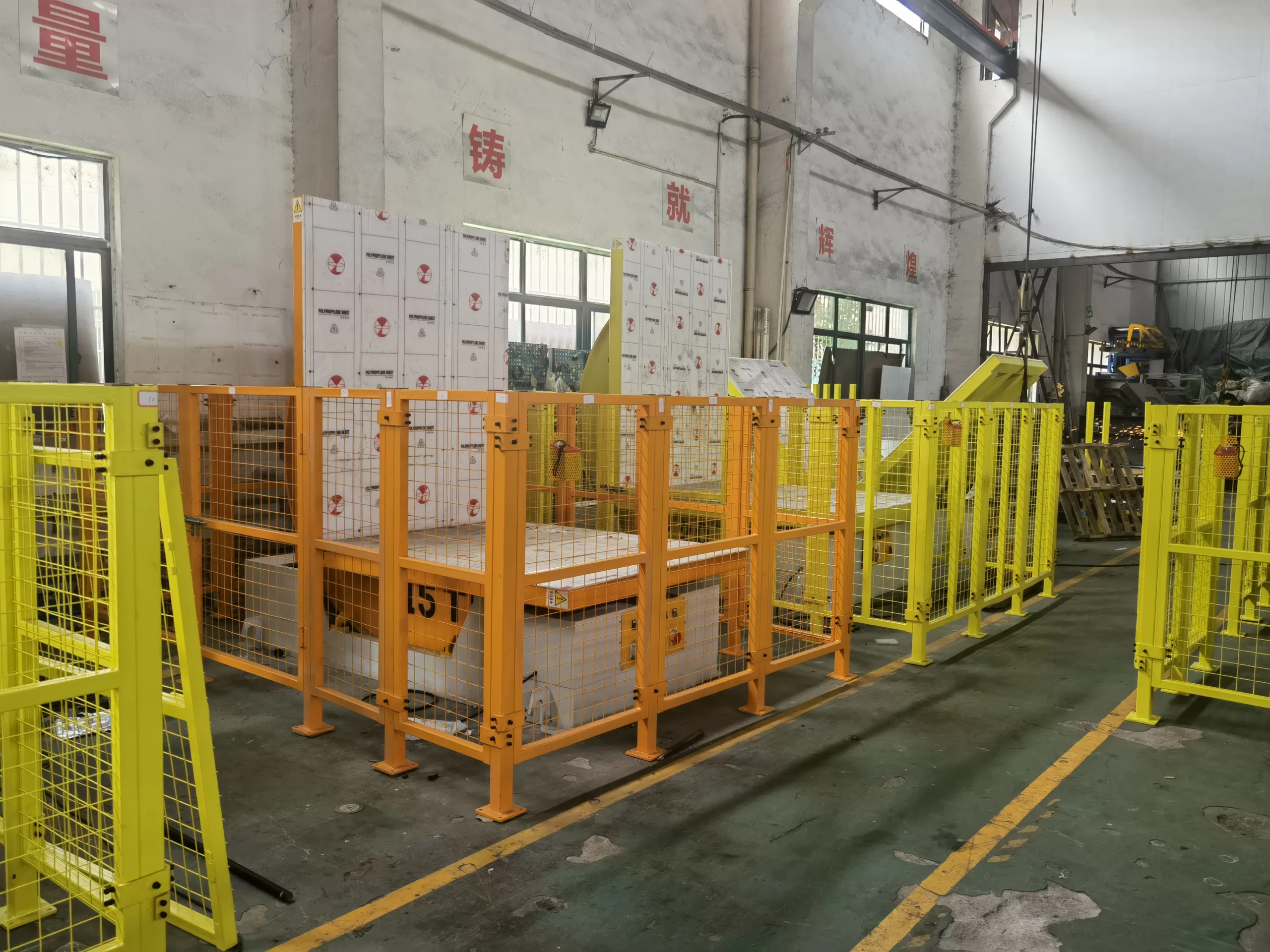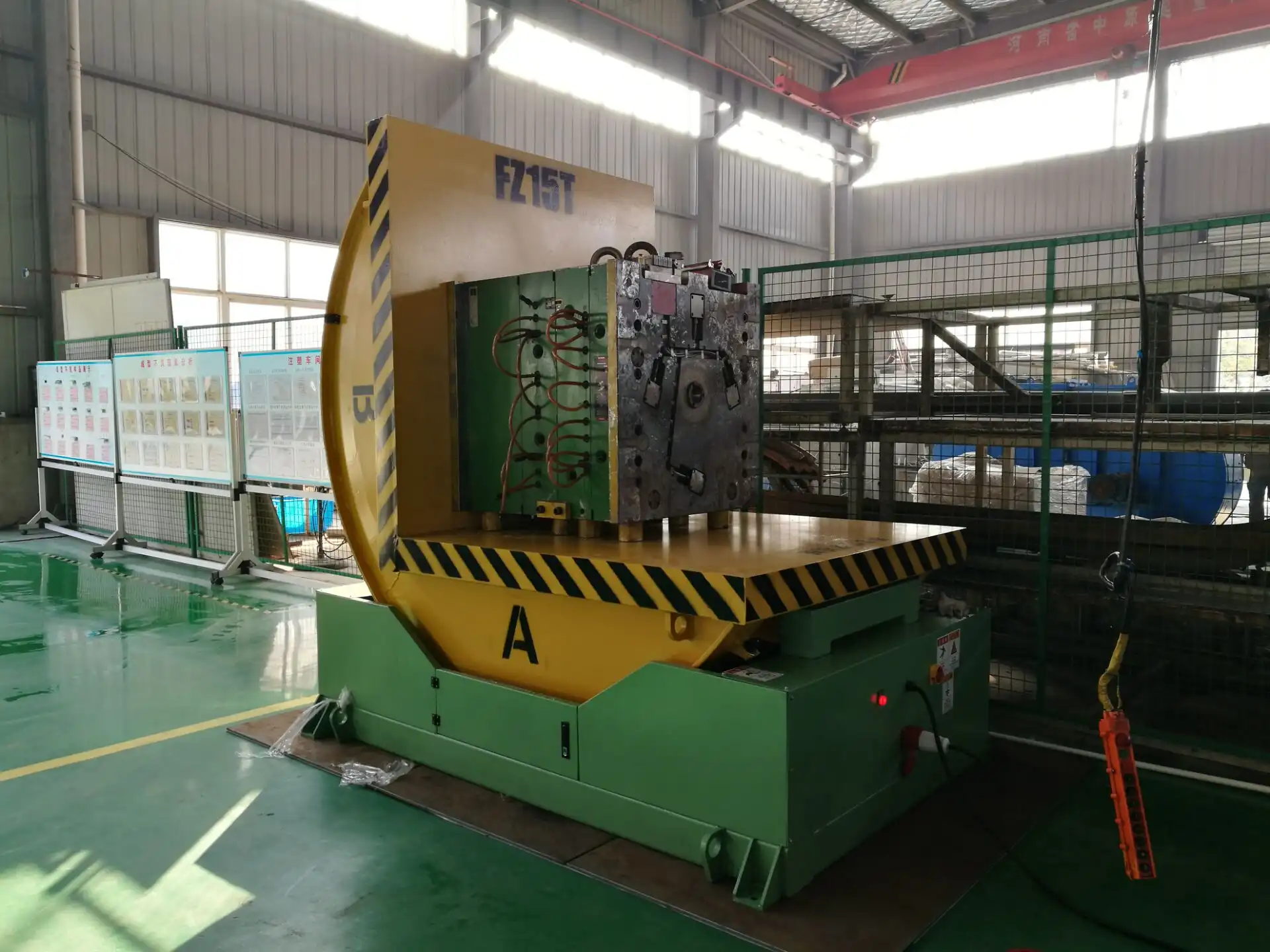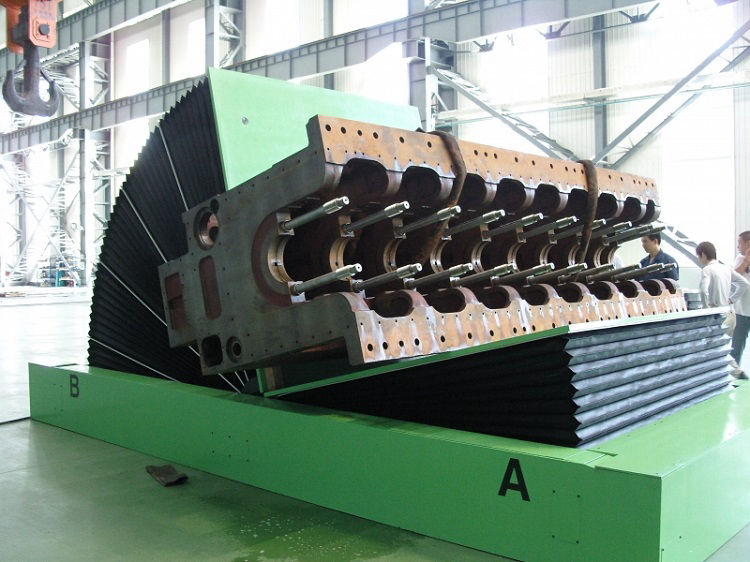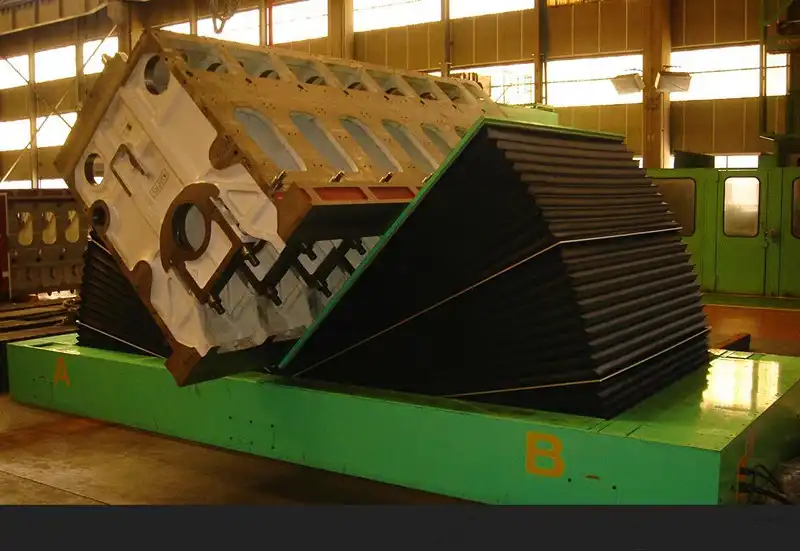Mold Flipper: Is Now the Right Time to Automate Die Handling in Thailand?
Handling heavy molds and dies is a constant challenge in manufacturing. For factory owners in Thailand, the traditional methods using cranes, chains, and manual labor are becoming a serious problem. These old ways are slow, inefficient, and create huge safety risks on the factory floor. Every time a heavy die is flipped manually, you are risking damage to expensive equipment and, more importantly, a serious injury to your workers. This isn't just a hypothetical problem; it's a daily reality that quietly eats away at your profits and puts your people in harm's way. The pressure to improve efficiency and meet stricter safety standards is growing. You know there has to be a better way. The solution is automation, specifically with a machine designed for this one critical task: the mold flipper. It offers a secure, controlled, and fast alternative that transforms a dangerous job into a safe, one-person operation.
Yes, now is the right time for Thai businesses to automate die handling with a mold flipper. Rising labor costs, increasing pressure for workplace safety compliance, and the need for greater production efficiency to compete in the global market make this technology a necessary investment, not a luxury.

I have spent my entire career in the packing and material handling industry. I've seen factories of all sizes struggle with the same issues. Many owners focus on the big production machines but overlook the small, in-between processes like die handling. But these "small" processes are often where the biggest gains in safety and efficiency are hiding. Investing in a mold flipper is one of the clearest and most impactful decisions a factory manager can make. It solves multiple problems at once. In the following sections, I want to break down the real costs of manual handling, show you how a mold flipper works, and help you understand the return on investment for your business in Thailand. Let's look at the facts together.
You see the wages you pay your team for handling molds every day. That is an obvious cost. But the most dangerous costs are the ones you don't see on a spreadsheet until it's too late. Think about what happens when a mold slips from a crane. The best-case scenario is a damaged die, costing thousands of dollars and weeks of production downtime to repair. The worst-case scenario is a catastrophic accident involving your employees. The medical bills, compensation claims, and government fines can be devastating for a business. These are the hidden costs that can cripple a factory overnight.
The hidden costs of manual die handling in Thai factories go far beyond wages. They include worker injury claims, damaged molds, production downtime, and decreased employee morale, often exceeding the cost of automation.

Digging Deeper into Unseen Expenses
When I talk with factory owners, I ask them to think beyond the direct labor costs. Let's break down where the real financial pain comes from when you rely on manual die handling. It is not just about one single event, but a combination of factors that constantly drain your resources.
Financial Costs Beyond Payroll
The most immediate hidden cost is equipment damage. A high-quality steel mold can cost tens of thousands of dollars. When it's handled improperly with chains and a crane, it's easy to scratch, dent, or even crack the surface. These repairs are not only expensive but also take the mold out of production. While it's being fixed, your production line stops. Another major financial risk is worker injury. In Thailand, workplace safety regulations are becoming more stringent. An accident can lead to significant direct costs, like medical treatment and worker's compensation. But it also brings indirect costs. Your insurance premiums will likely increase after an incident. You may also face legal fees and government penalties. These costs can add up to a sum that is many times the price of a mold flipper.
Operational Costs and Inefficiencies
Manual die handling is a huge bottleneck. It can take two or three skilled workers up to an hour to safely flip a large mold. During this time, your expensive press or injection molding machine sits idle. This is lost production time that you can never get back. This inefficiency also affects your production schedule. It makes it harder to plan quick changeovers for smaller batch orders, reducing your factory's flexibility. Furthermore, inconsistent handling can lead to quality issues. A mold that isn't set perfectly can produce faulty parts, leading to more scrap and wasted material.
The Human Cost
Finally, there is the human cost. Constantly asking your team to perform a high-risk task takes a toll on morale. Workers who feel unsafe are less motivated and less productive. It can also lead to higher employee turnover, forcing you to spend more time and money on training new staff. A safe work environment is a productive work environment. By showing your employees you care about their well-being, you build a stronger, more loyal team.
Here is a simple table to visualize these costs.
| Cost Category | Manual Handling (Annual Estimate) | With Mold Flipper (Annual Estimate) |
|---|---|---|
| Direct Labor Cost | ฿300,000 | ฿50,000 |
| Downtime Cost | ฿500,000 | ฿50,000 |
| Mold Repair/Damage | ฿250,000 | ฿10,000 |
| Injury/Insurance Risk | ฿150,000 (Variable) | ฿5,000 (Lower Premium) |
| Total Hidden Cost | ฿1,200,000 | ฿115,000 |
These are illustrative figures for a mid-sized Thai factory but show a clear financial case.
How does a mold flipper improve safety and efficiency?
Imagine your current process. Two or three workers gather around a heavy mold. They attach chains and hooks, communicating with a crane operator. The massive steel block is slowly lifted, and it swings in the air as they try to turn it. Everyone holds their breath. It is a slow, tense, and dangerous procedure. This is the bottleneck that stops your production line and puts your team at risk every single day.
A mold flipper dramatically improves safety by providing a stable, secure platform for turning heavy dies, eliminating the risks of using cranes and chains. It boosts efficiency by reducing flipping time from hours to minutes, requiring only one operator.

A Tale of Two Processes
From my experience visiting hundreds of factories, the difference between manual handling and automated handling is like night and day. It is a fundamental shift in how you manage your workflow. The improvements are not small; they are transformative in both safety and speed.
The Safety Transformation
A mold flipper is designed with one primary goal: safety. The machine has a wide, stable base. The mold is placed on a sturdy platform, often with a non-slip surface. It is then securely held in place. The entire flipping operation is controlled by a single operator using a simple push-button remote control from a safe distance.
Let's break down the safety benefits:
- No Swinging Loads: The mold never hangs precariously in the air. It is always supported by the machine's structure. This eliminates the primary risk of crane-based handling.
- Controlled Motion: The flipping movement is smooth and predictable. Hydraulic or electromechanical systems ensure a gentle rotation, preventing sudden jerks that could damage the mold or the machine.
- Reduced Manpower: The process requires only one operator. This means fewer people are in the immediate danger zone during the operation.
- Ergonomics: The operator isn't physically straining to push, pull, or position the mold. This reduces the risk of back injuries and other musculoskeletal problems.
The Efficiency Leap
While safety is the biggest win, the efficiency gains are what directly impact your bottom line and production targets. The process of flipping a mold with a dedicated machine is incredibly fast.
Here is a comparison of the typical workflow:
| Step | Manual Process (with Crane) | Automated Process (with Mold Flipper) |
|---|---|---|
| Preparation | Clear area, gather 2-3 workers, attach chains | Move mold to flipper with forklift/crane |
| Lifting/Flipping | Crane lifts, workers guide, slow turn | Operator presses button from safe distance |
| Positioning | Lower mold, carefully detach chains | Mold is flipped and ready for next step |
| Total Time | 30 - 60 minutes | 3 - 5 minutes |
| Personnel | 2-3 skilled workers + 1 crane operator | 1 operator |
As you can see, a task that takes up to an hour and requires a team of people is reduced to a simple, 5-minute job for one person. This frees up your skilled workers and your overhead crane for other valuable tasks. For a factory that performs multiple mold changes a day, this time saving adds up to hours of extra production capacity each week. This directly helps achieve goals like increasing capacity utilization to 95%, a target that leaders like Javier Morales strive for.
What is the real ROI of a mold flipper for a Thai business?
As a business owner, you have to ask about the return on investment (ROI). A mold flipper is a piece of capital equipment, and it needs to pay for itself. It's easy to look at the price tag and hesitate. But focusing only on the initial cost is a mistake. You must look at the money it saves and the value it creates. The real ROI comes from adding up all the costs you will avoid in the future.
The real ROI of a mold flipper for a Thai business is typically realized within 12 to 24 months. This is calculated by combining direct labor savings with the significant financial benefits of reduced downtime, prevented mold damage, and lower insurance premiums.

More Than Just a Machine: An Investment in Profitability
I always tell my clients that a good machine doesn't cost money; it makes money. A mold flipper is a perfect example. It works for you every day by cutting waste and increasing output. Let's do a simple, practical calculation that any business owner in Thailand can apply to their own factory.
Calculating Your Payback Period
The payback period is the time it takes for the machine to pay for itself through savings. We need to look at tangible, measurable savings.
- Labor Savings: Let's say manual flipping requires 2 workers for 1 hour. A mold flipper needs 1 worker for 5 minutes (0.08 hours). If your average labor rate (including benefits) is ฿150/hour, the manual cost is ฿300 per flip. The automated cost is about ฿12. If you do 4 flips a day, that's a daily saving of over ฿1,150. Annually, that's more than ฿350,000 in labor savings alone.
- Downtime Reduction: If each manual flip costs you 55 minutes of lost production time on a machine that generates ฿5,000/hour in value, you save over ฿4,500 per flip. For 4 flips a day, that's ฿18,000 in recovered production value daily. The annual figure can easily be in the millions of Baht.
- Avoided Mold Damage: This is harder to predict, but let's be conservative. If you avoid just one major mold repair costing ฿200,000 over two years, that's an average saving of ฿100,000 per year.
Let's put this into a simple ROI table.
| Item | Value (Illustrative) |
|---|---|
| A. Investment Cost (Mold Flipper) | - ฿1,500,000 |
| B. Annual Labor Savings | + ฿350,000 |
| C. Annual Production Gain (from less downtime) | + ฿1,000,000 (Conservative) |
| D. Annual Avoided Repair/Damage Costs | + ฿100,000 |
| E. Total Annual Savings (B + C + D) | + ฿1,450,000 |
| Payback Period (A / E) | ~1.03 Years (or about 12.4 months) |
Tangible vs. Intangible Returns
The calculation above only includes the hard, tangible numbers. But the intangible benefits are just as important. Improved worker safety leads to better morale and lower employee turnover. This creates a more stable, experienced, and productive workforce. A reputation as a safe, modern employer can also help you attract better talent in Thailand's competitive labor market. Furthermore, the ability to perform quick changeovers gives you the flexibility to take on smaller, high-margin jobs that you might have previously turned down. This agility is a powerful competitive advantage. These benefits directly support the high-level goals of reducing operational costs and boosting overall profit margins.
How do you choose the right mold flipper supplier in Thailand?
You've seen the benefits and you are convinced that a mold flipper is the right move. Now comes a crucial step: choosing a supplier. All machines may look similar online, but the quality, reliability, and support can be vastly different. Choosing the wrong supplier can turn a smart investment into a long-term headache. You are not just buying a piece of steel; you are entering a partnership.
To choose the right mold flipper supplier in Thailand, look beyond price. Prioritize a supplier with proven engineering expertise, a strong track record, comprehensive after-sales support, and a deep understanding of local safety standards and operational needs.

A Partner, Not Just a Seller
I built my company, SHJLPACK, on the principle of being a partner to my clients. A machine is only as good as the support behind it. When you're evaluating suppliers for a critical piece of equipment like a mold flipper, you need to dig deeper than the product brochure and the price tag.
Key Questions to Ask a Potential Supplier
When you are talking to a potential supplier, either in Thailand or an international one that serves the Thai market, you need to act like an engineer. Ask tough, specific questions.
- What is the machine's construction? Ask about the type of steel used, the thickness of the frame and platform, and the quality of the welds. A heavy-duty machine should look and feel robust.
- What components do you use? Ask about the brand of the motor, the hydraulic system, and the electrical components (like sensors and switches). Are they from reputable, globally recognized brands? This is crucial for long-term reliability and ease of finding spare parts.
- What are the safety features? Does it have emergency stops? Limit switches to prevent over-rotation? Hydraulic safety valves to prevent collapse in case of a power failure? A good supplier will be proud to explain these features in detail.
- Can you provide customer references? Ask to speak with other companies, preferably in Thailand or Southeast Asia, that have bought their machines. A confident supplier will have happy customers.
- What does your after-sales support look like? This is perhaps the most important question. What is the warranty period? Do they have technicians available for installation and training? How quickly can they supply spare parts? A machine that is down for weeks waiting for a part from overseas is useless.
The Importance of a Supplier Who Understands Your Business
The best suppliers are those who take the time to understand your specific needs. They will ask you about the weight and dimensions of your molds, your factory layout, and your workflow. They will recommend a machine that is correctly sized and configured for your operation, not just the most expensive one. They act as consultants. This is the difference between a simple seller and a true strategic partner, the kind of relationship that business leaders like Javier Morales look for.
Here’s a simple checklist to help you compare suppliers:
| Evaluation Criteria | Supplier A | Supplier B | Supplier C |
|---|---|---|---|
| Engineering & Construction | |||
| Component Quality (Brands) | |||
| Comprehensive Safety Features | |||
| Customer References (Local) | |||
| After-Sales Support & Spares | |||
| Understanding of My Needs | |||
| Price & Value |
Don't let price be the only factor. A slightly more expensive machine from a top-tier supplier with excellent support is a much better long-term investment than the cheapest option with no backup.
My Insights
I remember when I was a young engineer, working on the factory floor. I saw an accident happen during a manual mold change. Nobody was seriously hurt that day, thankfully, but the heavy mold was damaged and the fear on my colleagues' faces is something I've never forgotten. That experience taught me a powerful lesson: safety is not a cost. It's the foundation of a good business. Later, when I started my own factory, the very first "support" machine I bought was an upender for our coils. My financial manager questioned the expense. He said we could use the crane. I told him, "We are investing in safety for our people and stability for our process. This machine will pay for itself." And it did, many times over.
The challenges that factory owners in Thailand face today—rising costs, pressure for efficiency, safety regulations—are not unique. I've seen these same pressures drive change in China, in Europe, and in Mexico. The companies that thrive are the ones that see these challenges not as threats, but as opportunities to modernize and improve. A client of mine, a steel plant owner much like the Javier Morales persona, once told me his philosophy. He said, "I don't buy machines. I buy solutions to my problems. And my biggest problems are risk and wasted time."
A mold flipper is exactly that: a solution. It solves the problem of risk. It solves the problem of wasted time. It is a simple, elegant piece of engineering that has a profound impact on a factory's operations. The decision to automate die handling is a signal. It tells your employees that you value their safety. It tells your customers that you are a modern, efficient, and reliable producer. And it tells your competitors that you are serious about building a strong, resilient business for the future. This is why I am so passionate about sharing this knowledge. Helping others succeed is the best way to give back to the industry that has given me so much.
Conclusion
Automating die handling in Thailand with a mold flipper is no longer a luxury. It is a strategic move for safety, efficiency, and future growth in a competitive market.





